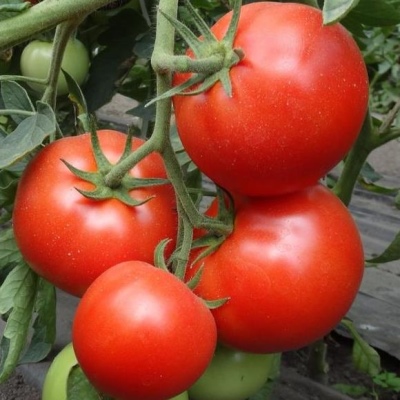
- Authors: Gavrish S.F., Kapustina R.N., Artemyeva G.M., Filimonova Yu.A., Redichkina T.A., Kibanova N.A. (LLC "Gavrish Breeding Firm")
- Year of approval: 2015
- Name synonyms: Star of Siberia F1
- Category: hybrid
- Growth type: determinant
- Appointment: fresh consumption
- Ripening period: mid-season
- Ripening time, days: 110-115
- Growing conditions: for open ground, for film greenhouses, for greenhouses
- Bush size: medium-sized
The Star of Siberia tomato appeared relatively recently. However, he has already managed to prove himself well in private gardens. And therefore, you should understand its features in order to get the best result.
Breeding history
The culture was created in the 2010s. Official permission for its cultivation was given in 2015. The main work was carried out in the breeding company "Gavrish". The project was supervised by breeders:
S. F. Gavrish;
R. N. Kapustina;
G. M. Artemieva;
Yu. A. Filimonova;
T. A. Redichkina;
N.A.Kibanova.
Description of the variety
A synonym for the name is the Star of Siberia F1. It is a determinant hybrid suitable for outdoor use. It can also be grown in standard and film greenhouses. Such a tomato reaches an average height (1-1.4 m). Moderately large green foliage develops on the bushes.
The main qualities of the fruit
At the moment when the tomato berries are just laid from the ovaries, they have a light green color. But then, when ripening occurs, this color changes to a red tone. The weight of the fruit is 160-180 g. In shape, the tomato resembles a flat circle, and its ribbing is very pronounced. Fruit development comes from simple inflorescences.
Taste characteristics
The Star of Siberia tomato is optimal for fresh consumption. Its flesh is firm and tender. In the reviews of farmers, the juiciness of such berries is also noted. Almost all consumers enjoy their sweet taste.
Ripening and fruiting
The Siberian Star is classified as a mid-season tomato. The required ripeness is reached in 110-115 days. The countdown is traditionally carried out after the appearance of the first green growth.
Yield
The official description mentions that it will be possible to harvest 10-11 kg of berries per 1 m2. The collection per 1 bush reaches 4-5 kg. Traditionally, it is worth emphasizing the importance of both actual weather conditions and agricultural technology.
The timing of planting seedlings and planting in the ground
You can start breeding seedlings in March or April. The specific period is chosen by themselves, taking into account the horticultural experience and conditions. You can transplant plants into the greenhouse in April or May. Transplantation into open ground is carried out in June.

Growing tomato seedlings is an extremely important process, because it largely depends on whether the gardener can harvest at all. All aspects must be taken into account, from seedbed preparation to planting in the ground.
Landing scheme
The use of plants in the 400x600 mm system is encouraged. Other planting schemes are not suitable or much less productive. It is not recommended to put too many plants in the garden. It is permissible to have no more than 4 bushes per 1 m2.

Growing and care
The cultivation of the Star of Siberia does not require any special efforts and difficulties. This plant requires the use of sunny areas. When planting, the soil is fertilized using:
10 kg of rotted humus;
0.01 kg of potassium sulfate;
0.03 kg superphosphate;
0.1 kg of wood ash.
Bushes Stars of Siberia must be formed in 3 or 4 shoots. Water the plant carefully and sparingly. When ovaries are created, feeding is minimized. This allows you to exclude an excessive build-up of green mass to the detriment of the fruits themselves. For such a tomato, it is very important to remove stepchildren and extra leaves, as well as systematically treat plantings from infections and pests.




A plant needs different micronutrients at each stage of growth. All fertilizers can be divided into two groups: mineral and organic. Folk remedies are often used: iodine, yeast, bird droppings, eggshells.
It is important to observe the rate and period of feeding. This also applies to folk remedies and organic fertilizers.


Resistant to adverse weather conditions
The star of Siberia can handle bad, cold weather quite well. And also the suppliers of the planting material indicate that the plant is able to survive severe moisture.
Growing regions
The Star of Siberia is allowed to be cultivated in West Siberian, Moscow Region and Far Eastern vegetable gardens. And also this tomato is allowed to be used in:
Karelia;
Leningrad region;
North Caucasian republics;
central Black Earth region;
the center of the European part;
Volga region;
the middle lane.

























































































